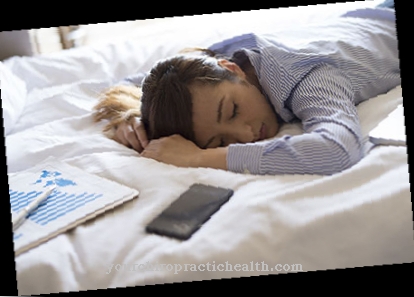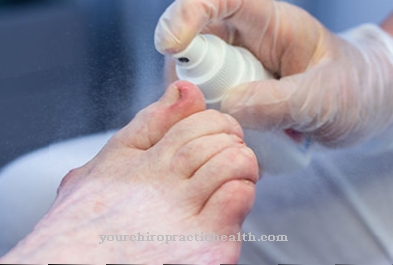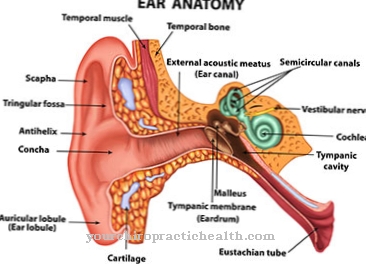Menstrual pain or Dysmenorrhea are among the most common concerns that gynecologists face. Many women and girls are affected and accept their suffering. To understand why menstrual pain occurs and how to treat and prevent them, read this post.
What are period pains?
.jpg)
© Kaspars Grinvalds - stock.adobe.com
Under primary Menstrual pain (Technical term: Dysmenorrhea) understand the type of pain that occurs during menstruation.
This is usually the case with affected girls and women from their first menstrual period. Period pain can often drag on to menopause if left untreated.
The side effects can vary from person to person and also vary greatly in strength.
Menstrual pain affects very young or very slim women more than average. Stress or emotional problems are factors that can make the suffering worse.
causes
Apart from the so-called secondary ones Menstrual pain, which can be caused by gynecological diseases such as cysts or fibroids, the "usual" type of menstrual symptoms is favored by the fact that pain messenger substances cause the muscles of the uterus to contract when the uterine lining is shed monthly.
The contraction of the muscles leads to a reduced blood flow to the uterus and this causes the sometimes unbearable pain. So it is a purely biological process that has nothing to do with any absurd theories.
Symptoms, ailments & signs
The pain many women experience during their monthly bleeding can vary in intensity. Some affected women are only plagued by mild symptoms. Others, on the other hand, complain of such severe symptoms that normal everyday life is hardly possible.
Typical symptoms of period pain are pain in the abdomen. These can be perceived as pulling, but strong cramps are also possible. Other complaints related to menstrual pain are diffuse abdominal pain, back pain, nausea, bloating and headache. Even with these symptoms, the intensity of the complaints can be very different.
For some women, signs of menstrual pain show up in the days leading up to the days. For most people, the symptoms are most pronounced with the onset of menstrual bleeding and persist in the first few days of their period and then slowly subside. Especially when the symptoms are combined with heavy bleeding for a few days, the women concerned experience them as extremely stressful.
Therefore, when the first signs of period pain appear, many people resort to appropriate medication that can alleviate the symptoms. Severe menstrual pain can also be a sign of an organic disease in the abdomen and should be examined by a doctor if the symptoms persist.
Course of disease
Women by primary Menstrual pain are affected, this is often from the first menstrual period to menopause. However, menstrual symptoms often weaken even after a few years of menstruation. This is because the complex hormonal cycle has to settle down in young women. Once this has happened, the symptoms also improve. Today no woman or girl has to live with these side effects anymore. Because a number of therapies have been developed, from naturopathic to chemical to nutritional drugs, which provide relief.
Many women experience their menstruation without any problems, while for others, abdominal pain, headache, nausea, tiredness, mood swings or a feeling of fullness even mean that they are unable to work. In extreme cases, it can lead to fainting. Severe general malaise and uncomfortable diarrhea can be other symptoms.
Complications
Serious complications are rare in menstrual pain and vary depending on the cause and form of the dysmenorrhea. As a result of primary dysmenorrhea, there is mainly a sharp decrease in quality of life. Affected women usually feel uncomfortable and suffer from severe discomfort. Secondary menstrual pain can be caused by serious medical conditions such as uterine inflammation or fibroids.
If these causes are not treated, further complications usually arise. Basically, the bleeding can lead to anemia and the resultant deficiency symptoms and physical discomfort. Vaginal infections and similar complaints cannot be ruled out in connection with menstrual pain.
Severe pain is rarely caused by a malformation or abnormal position of the uterus. More often, recurring dysmenorrhea indicates stress and other psychological distress, as well as an unhealthy lifestyle. Hormonal disorders can also be the underlying cause and, if not treated, cause further complications.
When treating menstrual pain, painkillers may cause symptoms. Although light preparations are usually prescribed, these can also cause headaches, gastrointestinal complaints and allergic reactions. If taken regularly, the liver and kidneys can be damaged.
You can find your medication here
➔ Medicines for menstrual crampsWhen should you go to the doctor?
Sexually mature girls and women experience very different pain experiences during their menstrual period. In addition, menstrual pain can vary in intensity and extent from cycle to cycle. Many sufferers already experience pain in the middle of the monthly cycle when ovulation occurs. This process is a natural process that does not have to be clarified by a doctor.
With the onset of menstruation, there is an increase in pain. In most cases it is not necessary to consult a doctor here either. Self-help measures and avoidance of strenuous physical activity are often sufficient. The majority of those affected learn in the course of time to deal with the complaints well and to find individual solutions to improve the discomfort. In addition to sporting activities, hot water bottles and relaxation techniques help.
If the period pain persists for more than two or three days, a doctor should be consulted. An increase in pain or severe impairment caused by the symptoms over a longer period of time should be clarified. A pale appearance, internal weakness or a strong feeling of illness should be examined. Dizziness, nausea, vomiting, or a disorder of consciousness should be presented to a doctor. If the pain leads to loss of consciousness, an emergency doctor must be called.
Treatment & Therapy
It has been shown that certain contraceptive products such as different forms of the pill cause menstrual symptoms and thus also Menstrual pain can significantly alleviate or even completely eliminate. The gynecologist must clarify which contraceptive pill is available. In addition, the pain reliever ibuprofen apparently inhibits the body's own pain messengers that cause the symptoms.
Increasing the intake of iron and magnesium before and during menstruation can also relieve pain. It has also been proven that regular exercise can be helpful because the pelvis is better supplied with blood overall and unpleasant side effects are prevented. Warmth can also be a helpful factor. Hot water bottles, saunas and a warm bath can sometimes relieve the cramps in the uterus and thus bring relief to those affected.
Many women prefer to use natural resources such as lady's mantle, yarrow or lemon balm in the form of teas. Relaxation techniques like yoga can sometimes help too. Acupuncture or acupressure by a doctor who has been trained in this area is also recommended. Which methods are used must ultimately be tailored to the individual case. But there is definitely help.
Aftercare
Follow-up care for period pain depends largely on the causes of the dysmenorrhea. Since these are often harmless in nature and do not require any special therapy, special follow-up care is not necessary. However, if those affected take medication for their period pain, for example, this should be discussed with the attending physician during regular check-ups in order to avert side effects and long-term stress on internal organs such as the liver or kidneys.
However, menstrual pain sometimes requires surgery on the abdomen, for example in the case of endometriosis. After an operation, appointments for follow-up care are very important, for example to check the wound or the structure of the uterus in the ultrasound. If unexpected pain or bleeding occurs in connection with menstrual pain and an operation, a specialist should be contacted as soon as possible outside of the appointments for follow-up care.
He can then determine whether the symptoms are still within the expected range during the follow-up care or whether special treatment is necessary. In rare cases, menstrual pain can also be associated with cancer. Here, too, it is important that the follow-up appointments are kept by the patient after the therapy is completed. Here, aftercare is primarily about recognizing new tumorous changes at an early stage and being able to act accordingly.
You can do that yourself
Various home remedies and measures can help with period pain. Proven remedies such as warmth in the form of hot water bottles and pads, bed rest and a walk in the fresh air bring relief from cramps and pain. In the case of severe symptoms, antispasmodic agents from the pharmacy, such as yarrow or aloe vera, help. Teas made from chamomile, duckweed, and lady's mantle have a similar effect and can be taken in conjunction with a relaxing bath.
Relaxation and breathing exercises are ideal as a distraction method. Autogenic training exercises help the body to calm down during intense complaints. This relieves the pain and also prevents the typical side effects such as tiredness and fatigue. In consultation with the doctor, alternative healing methods such as homeopathy or acupuncture can be tested.
If the dysmenorrhea does not decrease despite all measures, it is best to consult your gynecologist. The specialist can determine the causes of the intense pain and prescribe suitable countermeasures. Sometimes severe menstrual pain is caused by poor diet or lack of exercise, which must be managed in collaboration with a nutritionist or physical therapist.


.jpg)

.jpg)


















.jpg)



